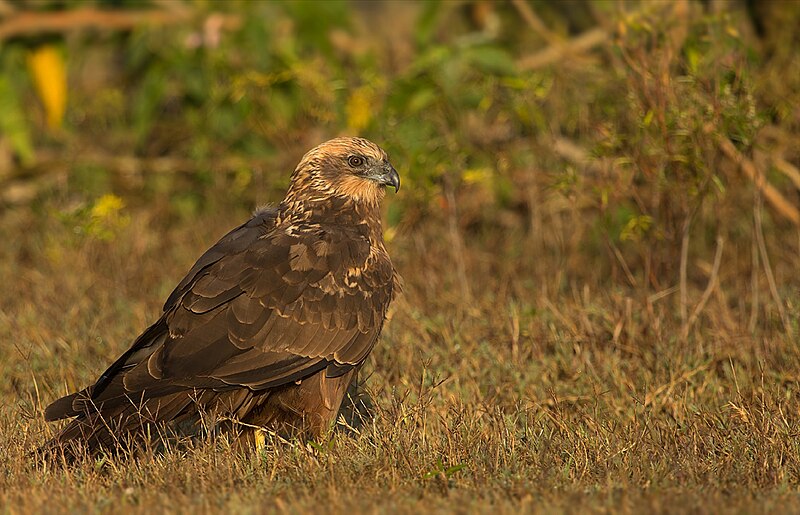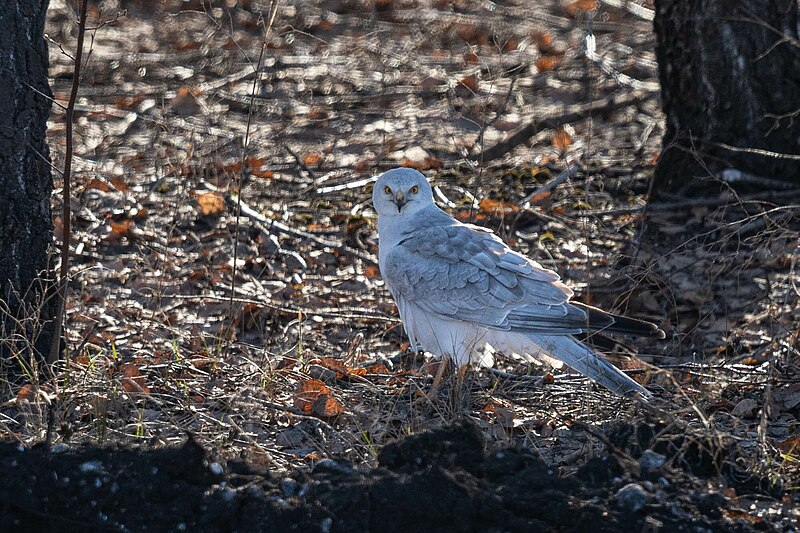Montagu’s Harrier Bird Details
Circus pygargus
Montagu’s Harrier,European Harrier, Grass Harrier, Dastmal Girgit mar Pattai;
Vilayati pattai
Carl Linnaeus, in 1761
Accipitriformes (HAWKS, EAGLES and KITES)
Accipitridae
Circus
Appearance :
Montagu’s Harrier exhibits sexual dimorphism. Males have a gray body with black wing tips and white underparts, while females are mostly brown with streaked underparts. Both sexes have a characteristic long tail and long wings, giving them a slender appearance.
Behaviour :
These harriers are known for their graceful flying style, often seen gliding low over fields. They are generally solitary or found in pairs, and they perform aerial displays during courtship.
Habitat :
Montagu’s Harrier prefers open habitats such as grasslands, fields, and marshes, particularly during the breeding season.
Diet :
Their diet mainly consists of small mammals (like voles), birds, and insects. They hunt by flying low and using their keen eyesight to spot prey.
Conservation Status :
Least Concern
Distribution :
Found across Europe and parts of Asia. During the breeding season, they are primarily observed in temperate regions of Europe and western Asia.
Population Size :
The global population is unknown and could be anything between 150,000 and 200,000 individuals
Life Span :
The average lifespan is about 3 to 5 years in the wild, though some individuals may live longer.
Body And Tarsus:
- Body: Montagu’s Harrier is a slender, medium-sized raptor with a graceful appearance. Males and females have different plumages (sexual dimorphism), where males are lighter in color compared to females.
- Tarsus Length: The tarsus length in Montagu's Harrier is generally around 5 to 6 cm.
Head And Bill :
- Head: The head is small and rounded with sharp eyesight and specialized feathers around the eyes to reduce glare. Males have grey heads, while females have brown ones.
- Bill: The bill is short, hooked, and adapted for tearing prey.
- Bill Length: Bill length is approximately 1 to 1.5 cm.
Length :
Montagu's Harrier ranges from 40 to 50 cm in length
Neck :
The neck is short and relatively inconspicuous, giving the bird a streamlined look in flight.
Size :
Montagu's Harrier is slightly smaller than other harriers, such as the Hen Harrier. It is a medium-sized raptor.
Tail Details :
- Tail: The tail is long, narrow, and slightly rounded, providing agility in flight.
- Tail Length: Tail length is generally 18 to 22 cm.
- Feathers: Males are predominantly grey with black wingtips, while females are brown with streaks. Both sexes have white rumps that are visible in flight.
Weight :
Males typically weigh 200 to 300 grams, while females weigh more, usually around 300 to 400 grams.
Wing :
The wings are long, narrow, and pointed, adapted for gliding and agile hunting.
Wing Span :
Montagu's Harrier has a wingspan of 97 to 115 cm.
Facial Feature :
Montagu’s Harrier has a distinct facial disc, which helps funnel sound to their ears, aiding in detecting prey. Males have a greyish-blue face, while females have a brown-streaked face.
Nest Details :
- Nest: Nests are built on the ground, often in tall grass or cereal crops, sometimes in low shrubland. Montagu’s Harriers prefer open, flat areas with good visibility.
- Nest Made Up Of: Nests are made from grasses, leaves, reeds, and small sticks, with soft materials like wool or feathers used to line the interior.
Breeding Season :
Montagu's Harriers typically breed from late April to July.
Nesting Season :
The nesting season begins in May and can extend into July.
Egg Color :
Eggs are usually white to pale bluish-white, sometimes with faint speckling.
Egg Length :
Egg length is approximately 40 to 45 mm.
Egg Width and Weight :
- Egg Width: Egg width is around 30 to 35 mm.
- Egg Weight: Eggs typically weigh about 20 to 25 grams.
Clutch Size :
The typical clutch size is 3 to 5 eggs, although it can range from 2 to 6 eggs depending on the food availability and environmental conditions.
No. of Broods :
Montagu’s Harriers generally have one brood per year. In rare cases, a second brood may occur if the first one fails early in the season.
Incubation Period :
The incubation period lasts for 28 to 30 days.
Nestling Period :
The nestling period is around 30 to 35 days, after which the young leave the nest.
Vocalization :
Montagu's Harrier is generally quiet, but during the breeding season, it may emit soft "chek-chek" calls. They are also known for their high-pitched whistles, particularly when alarmed.
Sex Demorphism :
Males and females are distinctly different in appearance. Males are light grey with black wingtips, while females are brown with streaks and barring on their wings and tail. The white rump is present in both sexes but more pronounced in males.
Migration Details :
Montagu’s Harriers are long-distance migrants. They breed in Europe and Central Asia and migrate to sub-Saharan Africa for the winter. Migration typically begins in late August to October, with birds returning to their breeding grounds in April to May.
Migration route: From breeding areas in Europe (including the UK, France, Spain, and Eastern Europe) and parts of Central Asia, they migrate across the Mediterranean into Africa, often through the Iberian Peninsula and crossing the Sahara Desert. They winter in the savannas and grasslands of West and Central Africa.

